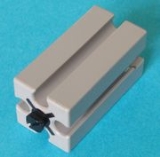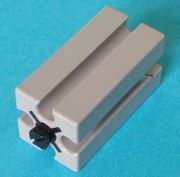
Fischertechnik
Encyclopedia

FischerTechnik is a brand of construction toy. It was invented by Artur Fischer and is produced by FischerTechnik GmbH in Waldachtal, Germany
Waldachtal
Waldachtal is a town in the district of Freudenstadt in Baden-Württemberg in southern Germany....
. Fans often refer to FischerTechnik as FT or ft. It is used in education for teaching about simple machines, as well as motorization and mechanisms. The company also offers computer interface technology which can be used to teach the theory of automation and robotics.
Origin
The company is a German manufacturer of fasteners, and the original FischerTechnik set was intended as a Christmas (1964) novelty gift for engineers and buyers at industrial clients. The gifts proved popular, so for Christmas, 1965, the company introduced its first building set for retail sale in Germany, in part, it has been claimed, to foster education and interest in technology and science among the young. By about 1970, the construction sets were being sold in the United States at upscale toy retailers such as FAO Schwarz.Building blocks
The basic building blocks were of channel-and-groove design, manufactured of hard nylonNylon
Nylon is a generic designation for a family of synthetic polymers known generically as polyamides, first produced on February 28, 1935, by Wallace Carothers at DuPont's research facility at the DuPont Experimental Station...
. Basic blocks came in 15x15x15 and 15x15x30 millimeter sizes. A peg on one side of each block could be attached into a channel on any of the other five sides of a similar block, producing a tightly-fitting assembly that could assume almost any shape. Red cladding plates could be used to complete the exterior surfaces of the models.
Girders
Many plastic FischerTechnik girders look like miniature versions of extruded aluminum framing of the T-slot nutT-slot nut
A T-slot nut is used with a threaded clamp to position and secure pieces being worked on in a woodshop. The T-slot nut slides along a T-slot track, which is set in workbench or table for a router, drill press, or bandsaw...
design.
A few FischerTechnik girders actually are made of aluminum.
Other companies make FischerTechnik-compatible aluminum bars of any desired length.
Accessories
The original blocks were characteristically gray with red accessories such as wheels and angled blocks. Electric motors, power sources, and gears were soon added to mobilize models. Additional building pieces such as struts were added in “statics” sets, allowing the construction of realistic-looking bridges and tower cranes. To teach the physics of such models, some sets included measuring devices so that trigonometric vectors could be calculated and tested.Electrical and electronic components
The early sets were sophisticated and were often used by engineers to teach and simulate industrial robotics. This use was advanced by the addition of electrical and electronic components such as microswitches, magnetic-sensing reed switches, and photocells, which sensed position and provided input to motors. With the basic electronic block (Grundbaustein) which contained an Operational amplifierOperational amplifier
An operational amplifier is a DC-coupled high-gain electronic voltage amplifier with a differential input and, usually, a single-ended output...
Schmitt trigger and Delay line
Delay line
Delay line may refer to:* Propagation delay, the length of time taken for something to reach its destination* Analog delay line, used to delay a signal...
circuits could be built. In the late 1970s, electronic binary-logic modules (AND, NAND, OR, NOR, Flip-flops) were introduced so that models could make some branching decisions. Pneumatic devices were made available to provide gripping ability. By the late 1980s, process-control CPU modules were added so that sequences movements could be preprogrammed and executed, first using “Lucky-logic” (LLWIN) software.
Kits for younger ages
As Lego became more sophisticated with its Mindstorms line, FischerTechnik attempted to move down into less technical, more “fun”, building kits for younger ages. The parts were molded from more colorful plastics, and small building sets were developed for simple models such as vehicles. However, the Fischer products were more expensive and had far fewer parts that replicated everyday objects than Lego. Especially in the United States, FischerTechnik never achieved parity with Lego in the general construction toy market, and FT is still more positioned as a product for schools, engineers, and hobbyists. The sets are not as available at retail as Lego products in the United States, or even in Europe.Robotic process control
By 2006, FischerTechnik sets were available for robotic process control using “Robo-pro” software (the successor to Lucky-logic), on-board process controllers with flash memory, infrared and radio-frequency remote control, and pneumatic-activation. Robotic models could follow preprogrammed routes or lines on the floor, sense obstructions and change course, detect and move objects, and simulate everyday devices such as vending machines, passenger elevator systems, and traffic-control lights. In early 2010, FischerTechnik introduced the ROBO TX Explorer kit, which includes a color sensor.Sets
FischerTechnik has produced a myriad of different sets over the years, and the company has several times renamed existing sets. Moreover, there have been as many as five different lines of these sets (often referred to as "A", "B", "C", "D", and "E" in fan circles) with similar but differing components (all compatible, of course). The following equivalencies can help make sense of some of the core sets:Start 300 = Start 200 + 50/3 = Start 100 + 50/2 + 50/3 = Start 50 + 50/1 + 50/2 + 50/3
Hobby 1 = UT1 = selected parts from Start 300 (but significantly abbreviated)
Hobby 2 = UT2 = Mot1 + Mot2 + Mot3 (The Hobby 2 / UT2 lacks the battery box that comes with Mot1.)
Hobby 3 = UT3 = EM1 + EM2 + EM3 (The "EM" stands for "Electro-Mechanical".)
Hobby 4 = UT4 = EC1 + EC2 + EC3 (The "EC" stands for "Electronic".)
Hobby S = Start 50S + 50S/1 + 50S/2 + 50S/3 (Note that those are "S" = "structural", not a "5".)
Note that prior to the FischerTechnik "C" line (1976?), the starter sets didn't have as many parts, and neither did their add-on kits (50/1, 50/2, 50/3). Because the older manuals lack copyright dates or official line designations, it is difficult to distinguish sets without in-depth knowledge of what was actually in the box for each line and set.
More recently, FischerTechnik has started producing a whole line of kits specialized for the construction of particular models, like boats, airplanes, bridges, cranes, etc. This is something of a departure from their traditional niche producing generic sets from which (literally) hundreds of different models can be built. FischerTechnik has also started producing advanced robotic sets, including battery packs, remote controls, and programmable control boards.

